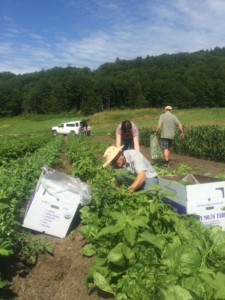This post was originally published on the UVM Food Feed Blog.
An estimated 70 billion pounds of food goes to waste in America each year, while nearly 48 million people in the United States feel the effects of food insecurity. Gleaning—the practice of collecting and donating excess foods—helps simultaneously address both waste and food insecurity. More important, it also gives low-income individuals access to fresh and locally grown foods that are not always available in their communities.
When it comes to gleaning, here are some compelling facts to consider:
- An estimated 25% to 40% of food grown, processed, and transported in the United States will never be consumed, according to Feeding America.
- When food is disposed in a landfill, it rots and becomes a significant source of methane, a potent greenhouse gas with 21 times the global-warming potential of carbon dioxide.
- More food reaches landfills and incinerators than any other single material in municipal solid waste.
- Vermont Foodbank’s gleaning program, the largest in the state, is a key part of our organization’s mission: to gather and share quality food and nurture partnerships so that no Vermonter will go hungry.
Through gleaning, the Foodbank collects 400,000 to 500,000 pounds of fresh and nutritious food that might otherwise go to waste. Through programs and services and fresh food deliveries to hundreds of food shelves and meal sites, the Vermont Foodbank is ensuring that Vermonters struggling with hunger have access to the healthiest food possible.
Gleaning is an incredibly fun and rewarding way to spend time at our beautiful local farms and help get nutrient-rich vegetables to our neighbors who are hungry. The Vermont Foodbank is gleaning in the Greater Burlington area and Windham County weekly, hosting groups and individuals throughout the season.
The Vermont Foodbank’s gleaning program began in 2008 and attracts 800 volunteers statewide.
In addition to gleaning, the Vermont Foodbank has a number of programs that work to address the food needs of our communities. The Foodbank gathers food from grocery stores, food manufacturers, farms, businesses, restaurants, individuals, and Feeding America, the national network of food banks.
Last year, the Vermont Foodbank shared 10 million pounds of food at food shelves and meal sites, schools, health care facilities, and housing sites. And through the work of programs like Community Kitchen Academy, VT Fresh (the Foodbank’s nutrition education program), and 3SquaresVT Outreach, the Vermont Foodbank is nurturing our neighbors, providing hope that when a family is struggling, someone is there to support them. Through these efforts the Vermont Foodbank serves 153,000 Vermonters annually—that’s one in four of our neighbors.
Please join us at a beautiful local farm this season! We will have regular, weekly gleanings schedule starting in mid-June and going through the beginning of November. If you are interested in volunteering, please sign up here: www.vtfoodbank.org/give-time/volunteer.
For any additional questions regarding gleaning in Northern Vermont, please email Andrea Solazzo at asolazzo@vtfoodbank.org.
